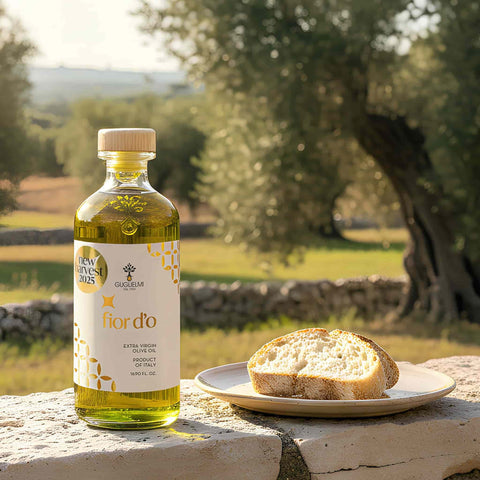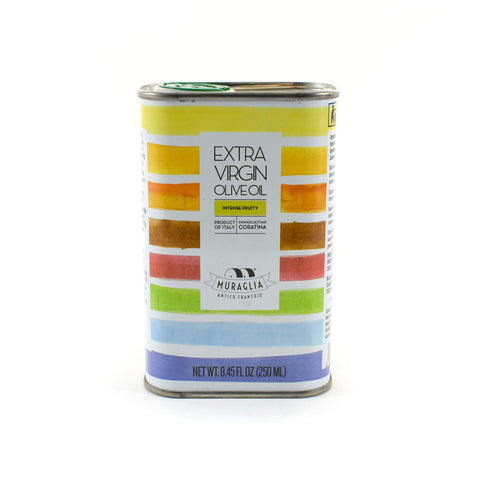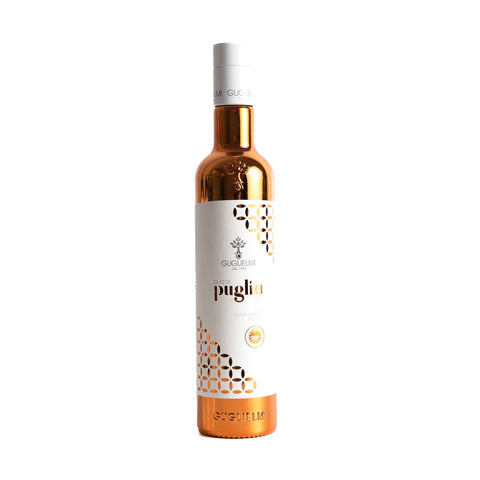Polyphenols in Olive Oil: Health Benefits & What to Look for
by Nicola Lando

Discover what polyphenols in olive oil are, how they affect taste and stability, plus which olive oils at Sous Chef have the highest polyphenol count.
In this guide, you'll learn about:
What are Polyphenols in Olive Oil?
Polyphenols are a group of natural compounds in olive oil that contribute to its flavour and aroma. They are the compounds that give olive oil its peppery, grassy notes.
Polyphenols are also found in many other fruits, vegetables, herbs and spices, tea, dark chocolate, and wine.
Polyphenol compounds act as antioxidants, which means they help protect oil from oxidation. So a high polyphenol will play a role in maintaining the freshness and quality of olive oil.
Plus, polyphenols are said to be anti-inflammatory, with the many health benefits linked to fighting inflammation.
The concentration of polyphenols in olive oil can vary significantly. Factors such as the type of olive used, the region where the olives are grown, and the methods of harvesting and processing all influence polyphenol levels.
Why Polyphenol Content Matters
Polyphenol content in olive oil can affect flavour and preservation. Oils rich in polyphenols might have a more robust, complex taste. In addition to improving taste, polyphenols help protect olive oil from spoiling. Oils with higher levels of these compounds are said to be more resistant to oxidation.
Plus, polyphenol compounds are also prized for being anti-inflammatory. Many people choose to seek out high polyphenol counts in olive oil, for the health benefits linked to reduced inflammation.
Health Benefits of Polyphenols in Extra Virgin Olive Oil
Extra Virgin Olive Oil (EVOO) is widely celebrated for its flavour and health benefits—especially thanks to its high levels of polyphenols. These powerful plant compounds act as antioxidants, helping to protect your body from oxidative stress and chronic disease.
Here’s how polyphenols in olive oil support better health:
Cardiovascular Health
- Help reduce LDL (“bad”) cholesterol and increase HDL (“good”) cholesterol
- Support healthy blood vessels and improve circulation
- Lower inflammation, which helps manage blood pressure
- Reduce the risk of heart disease and stroke
Cancer-Fighting Potential
- Oleocanthal, a unique polyphenol in EVOO, can destroy cancer cells without harming healthy ones
- Polyphenols may block tumour growth and support cell repair
- Research links EVOO consumption with lower risks of breast and colorectal cancer
Anti-Inflammatory Benefits
- Polyphenols help reduce chronic inflammation—a key trigger for many diseases
- May ease symptoms of arthritis and support joint health
- Help prevent inflammation-related conditions like type 2 diabetes
Brain and Longevity Support
- Antioxidants in EVOO may protect brain cells and slow cognitive decline
- Linked to improved memory and reduced risk of Alzheimer’s
- Core ingredient of the Mediterranean diet, associated with longer life expectancy
Factors Affecting Polyphenol Levels in Olive Oil
Polyphenol levels in olive oil are influenced by several key factors. And it's important to understand that the compounds diminish naturally over time.
- Olive Variety: Different olive varieties have varying polyphenol content. Varieties like Coratina, Koroneiki, Picual, and Moraiolo are known for their high levels. Knowing the type of olive used can guide you in choosing a rich, flavourful oil.
- Harvest: Olives harvested early in the season generally have higher polyphenol levels. Early harvest oils are often more robust and peppery in flavour, indicating a higher concentration of these beneficial compounds. Read our guide to new harvest olive oil!
- Climate and Soil: Growing conditions, including climate and soil quality, significantly impact polyphenol levels. Regions with optimal conditions for olive growth tend to produce olives with higher polyphenol content.
- Processing: The way olives are processed into oil affects polyphenol retention. Cold-pressing, which involves minimal heat, preserves more polyphenols compared to other methods. Opt for oils that use traditional cold-pressing techniques.
- Storage: Careful storage of olive oil is crucial. Light, heat, and air can degrade polyphenols. Oils stored in dark glass bottles and kept in cool, dark places retain their polyphenol content better.
What is a High Polyphenol Count?
The EU Regulation states that any oil over 250mg/kg is 'high' in polyphenols.
However, as polyphenol compounds degrade over time, it's important to consider whether your bottle has been stored correctly, in order to preserve the count over time.
How to Choose Olive Oil with Polyphenol Content
Selecting olive oil with high polyphenol content can make a significant difference in your cooking. Look for the polyphenol count, measured in mg/kg.
Here are some quick ways to find and maintain the polyphenol value in your olive oil:
- Extra Virgin Olive Oil: Always go for extra virgin olive oil. It's the least processed and retains more natural polyphenols, providing a richer flavour.
- Harvest Date: Oils within a year of harvest usually have higher polyphenol levels and better taste.
- Early Harvest/ New Season Oils: Olive oils made from the first harvests often have a more robust, peppery flavour - and higher polyphenol content.
- Olive Varieties: Some olive varieties are known for higher polyphenol levels. Varieties like Coratina, Koroneiki, Picual, and Moraiolo are good choices.
- Opaque Bottles: Choose olive oils stored in tins, ceramic jars or opaque packaging. Light can degrade polyphenols. To know more on how to store olive oil, read our guide here!
- Taste Test: Trust your palate - oils with a strong, pungent bite usually have higher polyphenol levels. A high polyphenol content often results in a and peppery taste. With notes of grass.
To know more on how to use and cook with extra virgin olive oil, read our guide here.
Frequently Asked Questions about Olive Oil Polyphenols
What are polyphenols in olive oil?
Polyphenols are natural compounds found in olive oil, contributing to its flavour and stability. They give the oil its peppery and bitter notes, making it distinct.
How can I tell if an olive oil has high polyphenol content?
Look for extra virgin olive oil (EVOO) with a recent harvest date. Early harvest oils and certain varieties like Coratina, Koroneiki or Picual often have higher polyphenol levels.
The following olive varieties produce extra virgin olive oil with a higher polyphenol content (Approximate in mg/kg):
- Picual (Spain): ~500-1000 mg/kg
- Koroneiki (Greece): ~400-800 mg/kg
- Cornicabra (Spain): ~400-800 mg/kg
- Frantoio (Italy): ~300-600 mg/kg
- Coratina (Italy): ~400-700 mg/kg
Please note that these values can vary depending on factors such as ripeness, climate, and extraction methods.
Why are polyphenols important in cooking?
Polyphenols enhance the flavour and stability of olive oil. Oils rich in polyphenols add depth to dishes and maintain quality better over time.
Can I use polyphenol-rich olive oil for frying?
While EVOO can be used for light sautéing, it's best to avoid high-heat frying. The unique flavours of polyphenol-rich oils are better suited for drizzling, dressings, and low-heat cooking.
How should I store olive oil to preserve polyphenols?
Store olive oil in a cool, dark place, away from light and heat.
Are there specific brands known for high polyphenol olive oils?
Look for trusted producers who focus on quality and transparency.
At Sous Chef southern Italian producers, Frantoio Muraglia, Galantino and Olio Guglielmi consistently have oils over 550mg/kg.
With an ultra-high polyphenol count of 1190mg/kg Guglielmi’s Fior D’O extra virgin olive oil is a fresh, unfiltered oil made from the first olives harvested in October. It has a vivid green-gold colour and the unmistakable taste of freshly pressed olives. It stands out from other extra virgin olive oils thanks to its creamy consistency and well-balanced flavour.
With a whopping 1748mg/kg, this olive oil is one of the highest polyphenol counts we've seen. It is made from cold-pressed Coratina olives – a variety native to the Apulia region of Italy. Coratina olives contain three times more polyphenols than any other Italian olive variety. This gives the oil its intense flavour, with spicy notes and hints of astringency.
With a polyphenol count of 722mg/kg, Olio Guglielmi IGP Puglia oil is an extra virgin olive oil - vivid green, with a golden hue. It is made from olives which are cold-pressed immediately after the harvest to preserve their flavour and polyphenols.
Shop the finest quality extra virgin olive oils, or read how to choose the best olive oil in the UK.

About the author
Nicola is co-founder and CEO at Sous Chef. She has worked in food for over ten years.
Nicola first explored cooking as a career when training at Leiths, before spending the next decade in Finance. However... after a stage as a chef at a London Michelin-starred restaurant, Nicola saw the incredible ingredients available only to chefs. And wanted access to them herself. So Sous Chef was born.
Today, Nicola is ingredients buyer and a recipe writer at Sous Chef. She frequently travels internationally to food fairs, and to meet producers. Her cookbook library is vast, and her knowledge of the storecupboard is unrivalled. She tastes thousands of ingredients every year, to select only the best to stock at Sous Chef.
Nicola shares her knowledge of ingredients and writes recipes to showcase those products. Learning from Sous Chef's suppliers and her travels, Nicola writes many of the recipes on the Sous Chef website. Nicola's recipes are big on flavour, where the ingredients truly shine (although that's from someone who cooks for hours each day - so they're rarely tray-bakes!).





